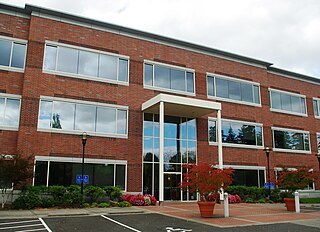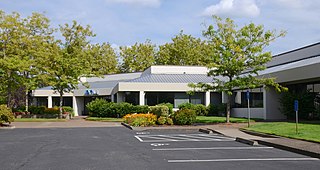
Silicon Forest is a nickname for the Washington County cluster of high-tech companies located in the Portland metropolitan area in the U.S. state of Oregon, and most frequently refers to the industrial corridor between Beaverton and Hillsboro in northwest Oregon.

Floating Point Systems, Inc. (FPS), was a Beaverton, Oregon vendor of attached array processors and minisupercomputers. The company was founded in 1970 by former Tektronix engineer Norm Winningstad, with partners Tom Prince, Frank Bouton and Robert Carter. Carter was a salesman for Data General Corp. who persuaded Bouton and Prince to leave Tektronix to start the new company. Winningstad was the fourth partner.

Reser's Fine Foods, Inc., an American corporation based in Beaverton, Oregon, manufactures and distributes fresh and refrigerated prepared foods. Over 1,000 products are available in the 50 U.S. states, Canada, Guam, Mexico, and areas of the Far East. Its prepared foods are sold in national grocery chains, independent outlets, and convenience stores. Oregon State University's football stadium, Reser Stadium, is named after the company, which is one of its sponsors. Reser’s is also a primary sponsor of Martin Truex Jr. and the #19 Toyota Camry in the NASCAR Cup Series. Reser's consistently ranks in the top ten privately held Oregon companies by annual revenue.
Radisys Corporation is an American technology company located in Hillsboro, Oregon, United States that makes technology used by telecommunications companies in mobile networks. Founded in 1987 in Oregon by former employees of Intel, the company went public in 1995. The company's products are used in mobile network applications such as small cell radio access networks, wireless core network elements, deep packet inspection and policy management equipment; conferencing, and media services including voice, video and data. In 2015, the first-quarter revenues of Radisys totaled $48.7 million, and approximately employed 700 people. Arun Bhikshesvaran is the company's chief executive officer.
Electric Lightwave, was originally formed in 1988, by John Warta, John Rivenburgh, Earl Kamsky and Richard Furnival. The company was formed to compete with US West and GTE in the Pacific Northwest. Portland General Electric was an initial investor, then Citizens Utilities became the largest investor in 1990. ELI became the first company to compete locally in Oregon, Washington, Idaho, Utah, and one of the first in California and Arizona.

Teledyne FLIR LLC, formerly FLIR Systems Inc,, a subsidiary of Teledyne Technologies, specializes in the design and production of thermal imaging cameras and sensors. Its main customers are governments and in 2020, approximately 31% of its revenues were from the federal government of the United States and its agencies.

Merix Corporation was an American printed circuit board (PCB) manufacturer based in Beaverton, Oregon. Prior to a merger in 2010 with Viasystems, the company had been the 31st largest public company in Oregon based on market capitalization as of 2006. The company is now part of TTM Technologies.

TriQuint Semiconductor was a semiconductor company that designed, manufactured, and supplied high-performance RF modules, components and foundry services. The company was founded in 1985 in Beaverton, Oregon before moving to neighboring Hillsboro, Oregon. In February 2014, Greensboro, North Carolina-based RF Micro Devices and TriQuint announced a merger in which the new company would be Qorvo, Inc., with the merger completed on January 1, 2015.
The OGI School of Science and Engineering, located in Hillsboro, Oregon, United States was one of four schools at the Oregon Health and Science University (OHSU). Until June 2001, it functioned independently as a private graduate school, the Oregon Graduate Institute of Science & Technology (OGI). OGI operated four departments and had approximately 330 students. In 2008, the school's name was changed to the Department of Science and Engineering and by 2010, the department was dissolved and the academic programs and research were disseminated to other OHSU institutes and departments.

Phoseon Technology is a privately owned electronic manufacturing company based in Hillsboro in the U.S. state of Oregon. Founded in 2002, the company makes products that use ultraviolet light produced by light emitting diodes (LED) that are used for curing products in industrial settings. Phoseon is located in the Portland metropolitan area and has offices in Europe and Asia. Bill Cortelyou is the chief executive officer and president of the firm.
Electro Scientific Industries, Inc. (ESI) is an American high technology company headquartered in the Portland, Oregon, metropolitan area, specifically in Beaverton, Oregon, since 2021, but from 1963–2021, it was based in the unincorporated Cedar Mill area just north of Beaverton. ESI is a developer and supplier of photonic and laser systems for microelectronics manufacturers. Founded in 1944, it is the oldest high-tech company in Oregon. Along with Tektronix, and later Intel, it has spawned numerous technology-based companies in the Portland area, an area known as the Silicon Forest. From 1983 to 2019, shares in the company were publicly traded on NASDAQ, under the ticker symbol ESIO.

C. Norman (Norm) Winningstad was an American engineer and businessman in the state of Oregon. A native of California, he served in the U.S. Navy during World War II before working at what is now Lawrence Berkeley National Laboratory. After moving north to Oregon, he started working for Tektronix before starting several companies in what became the Silicon Forest in the Portland metropolitan area. He founded or helped to found Floating Point Systems, Lattice Semiconductor, and Thrustmaster. Winningstad and his wife were also noted philanthropists in the Portland area, with a theater at the Portland Center for the Performing Arts named in his wife Dolores' honor.
Cascade Microtech is a semiconductor test equipment manufacturer based in Beaverton in the Portland metropolitan area of the United States. Founded in 1983, the Oregon-based company employs nearly 400 people. Formerly publicly traded company as CSCD on the NASDAQ, the company is now fully merged with FormFactor, Inc.

MathStar, Inc., was an American, fabless semiconductor company based in Oregon. Founded in Minnesota in 1999, the company moved to the Portland metropolitan area where it remained until it completed a reverse merger with Sajan, Inc. in 2010. MathStar never made a profit after raising $137 million over the lifetime of the company, including via several stock offerings while the company was publicly traded on the NASDAQ market. The company's only product was a field programmable object array (FPOA) chip.

Enli Health Intelligence was a privately held software company based in Beaverton, Oregon, and previously in Hillsboro, Oregon. Founded in 2001 as Kryptiq Corporation, the company specialized in electronic medical records and secure communications between physicians and patients. The 125-employee company was purchased by Surescripts in 2012, which was a previous investor in the company. Annual revenues at the time of the sale were approximately $25 million. In January 2015, the company announced that it was splitting from Surescripts and becoming independent again. Later in 2015, it was renamed Enli Health Intelligence. In 2021, it was acquired by Cedar Gate Technologies, which discontinued use of the Enli name.

Omega Morgan is a privately held company headquartered in Hillsboro in the U.S. state of Oregon. Founded in 1991, the 350-employee company specializes in heavy lifting, specialized transportation, machinery moving, crane and rigging services, plant relocations, equipment installations, millwrighting, and applied and industrial metrology.
BendBroadband is a cable television and internet provider in the U.S. state of Oregon. Based in Bend, it serves Central Oregon and also owns several television stations and a data center. As of September 2014, the company became a wholly owned subsidiary of Telephone and Data Systems, a Fortune 500 company.

Qorvo is an American multinational company specializing in products for wireless, wired, and power markets. The company was created by the merger of TriQuint Semiconductor and RF Micro Devices, which was announced in 2014 and completed on January 1, 2015. It trades on Nasdaq under the ticker symbol QRVO. The headquarters for the company originally were in both Hillsboro, Oregon, and Greensboro, North Carolina, but in mid-2016 the company began referring to its North Carolina site as its exclusive headquarters.

Oregon Venture Fund makes venture investments in the Portland, Oregon area and throughout Oregon and SW Washington. The fund consists of 180 institutional and angel investors, of whom 85% have run or founded a business. The fund evaluates up to 300 business plans per year, selecting five to seven to invest in annually. In 2018, the fund changed its name from Oregon Angel Fund to Oregon Venture Fund and launched a new $30M fund. Since its inception, Oregon Venture Fund has generated an average annual rate of return of 34% and a return on investment exceeding $3.50 for each dollar invested.

PacStar, part of Curtiss-Wright Corporation's Defense Solutions Division, is a developer and manufacturer of tactical communication and information technology infrastructure hardware and software based in Portland, Oregon. The company was founded in 2000 in Oregon as a reseller of advanced networking and communication equipment and in 2005 began manufacturing communications systems of its own design. The company has multi-million dollar deals with several branches of the US military and also supplies rugged networking equipment to commercial industries. The formerly privately held company was acquired by Curtiss-Wright in late 2020.













